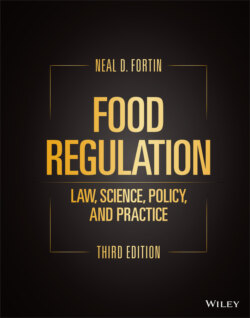Читать книгу Food Regulation - Neal D. Fortin - Страница 129
3.4.6 Labeling Special Circumstances Product Dates and Codes
ОглавлениеSell‐by or use‐by dates may voluntarily be included on food labels. However, other than for infant formula, there is no federal requirement for such dating.57 However, a “pack date” is required for poultry products and thermally processed, commercially sterile USDA‐regulated products to identify production lots and facilitate trace‐back activities in the event of foodborne illness.58
Product dating is either closed or open. “Open dating” is designed to communicate to consumers. “Closed dating” is a code for manufacturers to identify the date, time, and location of production. In open dating, dates are stated alphanumerically, such as “Oct. 15,” or numerically, such as “10‐15” or “1015.” In code dating, the information is coded in letters, numbers, and symbols so that usually only the manufacturer can translate it. For example, “Packed on 12/15/2020” is an open date, and “22:5220125” is a closed date code.
A wide variety of food date label descriptors are used. There is no uniform or universally accepted terminology. The common descriptors are the following:
“Sell By” or pull date is the last day that the manufacturer recommends that the food be displayed for sale and is used for inventory management. It is not a safety date. This date must allow additional time for consumer storage and use at home, so if the food is bought on the pull date, it still can be eaten at a later date. The product must be safe for consumers to use for a reasonable period of time beyond the sell‐by date.
“Best if Used By” or “Best if Used Before” date is a recommended late date to use a product while at peak flavor or quality. This is a quality assurance or freshness date and not a safety date except for when used on infant formula. This date shows how long the manufacturer thinks a food will be of optimal quality. This doesn’t mean, however, that the product shouldn’t be used after the suggested date.
Expiration date. This is the last day on which a product should be eaten. Some state governments regulate these dates for perishable items, such as milk and eggs. FDA regulates only the expiration dates of infant formula.
Closed dating, such as cans codes, indicate when and where the product was canned. These codes are not meant for as “best by” dates. Thermally processed, low‐acid foods and acidified food in hermetically sealed containers must have a code that identifies the establishment where packed, the product contained therein, the year packed, the day packed, and the period packed.59 FDA encourages manufacturers to put product codes on other packaged foods, especially for products with a long shelf life. In the case of a recall, this makes it easier to quickly identify and track down the product and take it off the market.
